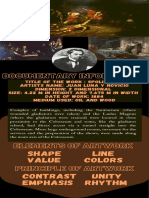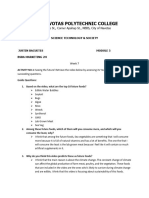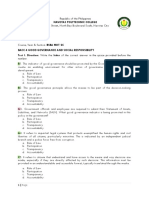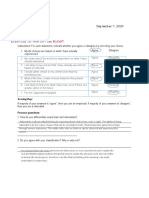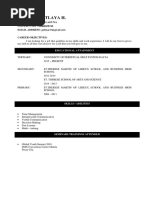Module 2
Uploaded by
Rexson Dela Cruz TagubaModule 2
Uploaded by
Rexson Dela Cruz TagubaNSTP 2 – NATIONAL SERVICE TRAINING PROGRAM 2
Dr. Herminigildo S. Villasoto
……..LEARNING OBJECTIVES…………………………………………………………………………………..
At the end the chapter, the student will be able to:
1. Understand how service-learning leads to effective community intervention and active
participation;
2. Recognize the different strategies applied or adopted in community services and
intervention; and
3. Appreciate the spirit behind service-learning and community involvement.
……..OVERVIEW………………………………………………………………………………………………….
This chapter deals with the guidelines and procedures of community service-learning. It
integrates meaningful community service and reflection to enrich the students’ learning
experience and social development.
……..LECTURE…………………………………………………………………………………………….………
Service-learning provides students the opportunity to work with others, gain valuable insights,
and acquire different skills. Through varied community projects, they can apply what they
have been taught in class by formulating appropriate solutions to the problems they
encounter in their chosen communities.
An enrollees of NSTP-CWTS 2, students can use the insights that they gain in the classroom
and provide solutions to real-life problems in the community. They become bona fide
members of their assigned communities as they render service and perform acts like the
following:
1. Analyze the effect of natural disasters and use a kit to gather important items during
disaster preparation. Elementary students can design and distribute these kits to the
members of the community.
2. High school students can closely monitor the effects of poor nutrition and lack of
exercise by organizing health-related activities, concoct nutrition recipes, and putting
up fruits and vegetables stands in the schools in the community.
REXSON D. TAGUBA, LPT
Guro sa Filipino
NSTP 2 – NATIONAL SERVICE TRAINING PROGRAM 2
Dr. Herminigildo S. Villasoto
3. To eliminate invasive aquatic species, biology majors can study the complexity and
diversity of wetlands. Streams can also be monitored and the results presented to the
class.
4. University students can help struggling local non-profit organizations cope with difficult
economic conditions. Students who are enrolled in communication-related courses can
provide varied public relations services with community partners, develop press kits and
provide assistance in holding events.
Characteristics of Service-learning
The common characteristics of service-learning include the following:
1. It brings good, substantial, and practical results for the participants.
2. It promotes cooperation rather that competition where the skills associated with
teamwork and active community involvement are developed.
3. It gives appropriate rather than simplified solutions to problems seriously affect the
community.
4. It provides real-life experiences wherein students gain knowledge from a particular
community engagement activity rather than from a textbook. Through these direct
experiences, service-learning offers great opportunities for students to develop their
critical thinking skills and learn how to identify relevant and emerging issues in
community settings.
5. It gives students a deeper understanding of concepts and real-life situations in the
community through immediately observable results.
6. Through an immediate understanding of a situation in the community, service learning
becomes a more significant experience for students leading to their emotional and
social development and cognitive learning.
Service-learning is NOT:
1. An episodic volunteer program
2. An add-on-course to an existing school or college curriculum
3. Logging a set of community service hours in order to graduate
4. Compensatory service assigned as a form of punishment by the courts or by school
administrations
5. Only for high school or college students
6. One-sided, that is, beneficial only to the students or the community
The distinctive element of service-learning is that it enhances the community through the
service provided, and also results in the educational improvement of the students and the
other people providing the service. Service-learning is rapidly growing and becoming popular
REXSON D. TAGUBA, LPT
Guro sa Filipino
NSTP 2 – NATIONAL SERVICE TRAINING PROGRAM 2
Dr. Herminigildo S. Villasoto
because of its powerful impact on people and their development. It is a dynamic process,
through which the students’ personal and social growth are tightly interwoven into their
academic and cognitive advancement. According to Eyler and Giles (1999), the service-
learning model enhances understanding and leads to more effective action.
Service-learning Theory
Service-learning is a form of experiential education wherein learning occurs through cycles
of action and reflection. Students work with others in applying what they have learned in class
to solve community problems while, at the same, reflecting upon their experiences as they
seek to attain their goals for the community and a deeper understanding and skills for
themselves (Eyler and Giles, 1999).
Legal Bases of Service-learning
Service-learning is based on RA 8292, also known as the Higher Education Modernization Act
of 1997. This law reiterates Section 2 (1)of Article XIV of the 1987 Constitution by declaring that
the “policy of the state is to establish, maintain, and support a complete, adequate, and
integrated system of education relevant to the needs of the people and the society.” This
policy can be attained through the HEI’s trilogy of functions – academics (teaching and
learning), research and extension (community service) – and their keeping in mind of their
legal responsibility to act as effective agents of change and development.
HEIs on Service-learning
One of the trifocal functions of the university is community extension. According to Tariman
(2007), its duty to the youth is to make them literate and functional, so they can make good
decisions regarding the problems affecting their health, families, and duties and responsibilities
to the community. They should be provided with opportunities for cooperative undertakings
affecting the welfare of the entire community, so they can develop into young men and
women who look upon their own interests in terms of the welfare of others.
Benefits of Service-learning
Service-learning has potential benefits to the students, faculty and community.
Students in service-learning classes can be benefit academically, professionally, and
personally. They will:
1. Increase their understanding of the class topic
2. Gain firsthand experience (possibly leading to a future internship or job)
3. Question or defend values and beliefs
4. Have the opportunity to act on values and beliefs
REXSON D. TAGUBA, LPT
Guro sa Filipino
NSTP 2 – NATIONAL SERVICE TRAINING PROGRAM 2
Dr. Herminigildo S. Villasoto
5. Develop critical thinking and problem-solving skills
6. Increase their knowledge of diverse cultures and communities
7. Learn more about social issues and their causes
8. Improve their ability to handle difficult situations
9. Be open to change and become more flexible
10. Develop or enhance their skills, especially in the areas of communication, collaboration,
and leadership
11. Test out the skills, interests, and values required in a potential career path and learn more
about their field of interest
12. Connect with professionals and community members who will also learn from the
service-learning program
13. Grow a professional network of people, whom they can contact later for career growth
14. Be encouraged in joining public service or social organizations
There are personal and professional benefits that faculty members can derive from
integrating service-learning into the courses they handle. Their decision to teach SPL classes
can:
1. Promote interactive teaching as well as reciprocal learning between them and their
students
2. Provide new concepts and subjects that will enrich the class
3. Open up new areas of concern for research
4. Motivate their students to engage in active learning and be exposed to varied teaching
styles
5. Enable their students to learn more and further develop themselves
6. Increase enrollment by giving the proper motivation to highly engaged and active
students
7. Enhance the leadership potential of their students
8. Expose their students to networking with active faculty members in other disciplines
9. Promote quality relationships between them and the members of the community or the
institution; this will facilitate collaborative endeavors.
10. Offer firsthand information or concepts and opportunities for community involvement;
this will help them understand and resolve issues.
Community partners involved in service-learning can:
1. Receive additional human resource assistance that can expedite the achievement of
organizational goals
2. Inspire a higher level of enthusiasm, perspective and energy
REXSON D. TAGUBA, LPT
Guro sa Filipino
NSTP 2 – NATIONAL SERVICE TRAINING PROGRAM 2
Dr. Herminigildo S. Villasoto
3. Improve the organization’s pool of volunteers; students engaged in service-learning will
boost their own morale; this will lead them to share their experiences with their
classmates and friends
4. Enhance public awareness regarding significant issues confronting the community
5. Ensure future support for the organization
6. Make students well informed regarding issues in the community; community partners
can also enlighten them regarding common misconceptions
7. Prepare the youth of today, particularly students, to become tomorrow’s responsible
community leaders
8. Establish strong networks with partners in other organizations and agencies
9. Gain access to the other resources of the university and strengthen collaborative ties
with its faculty members, students and staff.
Guidelines and Procedures
A. PREPARATORY STAGE
Faculty members interested in conducting service-learning must see to it that the
service0learning program (SLP) is indicated in the syllabus.
1. The students and faculty members are both responsible for the selection of the
community or institution.
2. The faculty member must submit a letter of intent to the college dean through the
chairman or the head of SLP.
3. The faculty member will write a letter of intent and request for permission to conduct
a SLP to the selected community or institution
4. The students who will join the SLP must secure a waiver from the office of student
affairs (OSA) to be signed by their parents or guardians.
B. IMPLEMENTATION STAGE
1. The students and the supervising faculty member of the SLP are required to wear the
prescribed school identification card (ID) and college T-shirt and observe decorum
while in the community or institution.
2. The students and faculty member on the SLP shall cover their perspective
transportation, communication, and meal expenses during the period.
3. The faculty member or the assigned group leaders shall take responsibility for all
communications and coordination with the partner community or institution in
relation to the SLP.
4. The college dean or the head of the program will conduct spot monitoring or follow-
up of students involved in the SLP to determine the actual and current status of the
program.
REXSON D. TAGUBA, LPT
Guro sa Filipino
NSTP 2 – NATIONAL SERVICE TRAINING PROGRAM 2
Dr. Herminigildo S. Villasoto
5. In case the faculty member in-charge will be absent, he/she must inform and ask
permission from the college dean to find another faculty member as substitute to
supervise the students.
C. POST-ACTIVITY EVALUATION STAGE
1. The students must submit a narrative report with pictorial documentation and
reflection paper to the faculty member. The report must be hardbound, follow the
required format, and submitted fifteen days (15) after the SLP activity.
2. The faculty member will evaluate student’s narrative report using the assessment tool
that is designed for this activity. The performance of the students will be evaluated
using the same rubrics. The two evaluation results will be added and then divided by
two. Its average will be the grade of the SLP student, representing ten percent (10%)
of the total computed grade for the term.
3. The college/university through the chairman or head of the program must conduct
an exit conference with the community or institution beneficiaries/leaders to assess
the service-learning program (SLP) implemented.
4. A certificate of SLP completion shall be issued by the college/university upon the
written request of the faculty member in charge.
5. The college/university shall issue a certificate of appreciation to the cooperating
community or institution upon the completion of the service-learning activities.
……..CONCLUSION……………………………………………………………………………………………...
Service-learning is applied in a wide variety of settings, including schools, universities, and
community- and faith-based organizations. It can involve a group of students, a classroom,
or an entire school. Students build character and become active participants as they work
with others in their school and community in various service projects designed for the
development of education, public safety, and the environment.
Service-learning provides an important service to the community. Students develop an
understanding of actual social, political, economic, and environmental issues in their
assigned communities.
REXSON D. TAGUBA, LPT
Guro sa Filipino
NSTP 2 – NATIONAL SERVICE TRAINING PROGRAM 2
Dr. Herminigildo S. Villasoto
…….APPLICATION……………………………………………………………………………………………
Name ________________________________________________Course and Level _________________
Facilitator _____________________________________________Date _____________________________
A. Relate the following questions to real-life situations and write your answers on the
space below.
1. What public awareness campaigns are needed to resolve the issues and problems
in your community?
2. If you were given the chance to organize students to participate in a three-year
strategic planning for a service-learning program, how would you lead your team?
REXSON D. TAGUBA, LPT
Guro sa Filipino
NSTP 2 – NATIONAL SERVICE TRAINING PROGRAM 2
Dr. Herminigildo S. Villasoto
…….REFLECTION……………………………………………………………………………………………
Name ________________________________________________Course and Level _________________
Facilitator _____________________________________________Date _____________________________
A. Write your reflection on the space provided.
1. What real-life experiences have you gained after a particular community
engagement?
2. In what ways have your experiences significantly developed your cognitive
learning?
REXSON D. TAGUBA, LPT
Guro sa Filipino
NSTP 2 – NATIONAL SERVICE TRAINING PROGRAM 2
Dr. Herminigildo S. Villasoto
…….EXERCISE 2……………………………………………………………………………………………
Name ________________________________________________Course and Level _________________
Facilitator _____________________________________________Date _____________________________
A. On the space provided, discuss substantially the following topics:
1. A scenario in which students apply what they have learned in the classroom to the
SLP.
REXSON D. TAGUBA, LPT
Guro sa Filipino
NSTP 2 – NATIONAL SERVICE TRAINING PROGRAM 2
Dr. Herminigildo S. Villasoto
2. The importance for students to know the basis in law of the SLP.
B. MULTIPLE CHOICE. Write the letter that corresponds to the correct answer on the
space provided.
_____1. It is a form of experiential education.
a. Service-learning
b. Comparative-learning
c. Participatory-learning
d. Cooperative-learning
_____2. It is also known as the Higher Education Act of 1997.
a. RA 9161
REXSON D. TAGUBA, LPT
Guro sa Filipino
NSTP 2 – NATIONAL SERVICE TRAINING PROGRAM 2
Dr. Herminigildo S. Villasoto
b. RA 8262
c. RA 6165
d. RA 6175
_____3. It is a form of experiential education wherein learning occurs through cycles of action
and reflection. Students work with others and apply what they have learned in class to the
community.
a. Service-learning
b. Aesthetic-learning
c. Cooperative-learning
d. Individual-learning
_____4. Securing ___________ from the office of the student affairs is necessary. It must be
signed by the student’s parents or guardians as a part of the protocol in program
implementation.
a. Program
b. Activities
c. Syllabus
d. Waiver
_____5. This activity combines service and learning objectives. It aims to transform the lives of
both the recipients and the providers of the service.
a. Service-learning
b. Aesthetic-learning
c. Cooperative-learning
d. Individual-learning
C. TRUE or FALSE. Write T if the statement is correct and F if it is not.
_____1. Students and faculty members involved in SLP are required to wear the prescribed
school ID and college T-shirt while in the community.
_____2. The college/university shall issue a certificate of appreciation to the cooperating
community upon the completion of the service-learning activities.
_____3. Partnerships and other successful relationships and connections can be developed
while participating in community service.
REXSON D. TAGUBA, LPT
Guro sa Filipino
NSTP 2 – NATIONAL SERVICE TRAINING PROGRAM 2
Dr. Herminigildo S. Villasoto
_____4. In the implementation of the program, students and faculty members should be
realistic when assessing the limitations of the community and the school.
_____5. Students can develop or enhance their skills, especially in the areas of
communication, collaboration, and leadership in implementing the program.
REXSON D. TAGUBA, LPT
Guro sa Filipino
You might also like
- Chapter 3 - Digital Technology and Media Literacy0% (3)Chapter 3 - Digital Technology and Media Literacy9 pages
- Innovative Technologies For Assessment Tasks in Teaching and100% (6)Innovative Technologies For Assessment Tasks in Teaching and31 pages
- Demonstrate What Culture Is and How It Influence Moral DevelopmentNo ratings yetDemonstrate What Culture Is and How It Influence Moral Development4 pages
- First Condition of Equilibrium: ObjectiveNo ratings yetFirst Condition of Equilibrium: Objective11 pages
- Directions: in Your Own Words, Answer The Following Questions Based On The LessonsNo ratings yetDirections: in Your Own Words, Answer The Following Questions Based On The Lessons3 pages
- 10 Ways Speakers of The World Are Changing The Language and 5 Popular Singlish WordsNo ratings yet10 Ways Speakers of The World Are Changing The Language and 5 Popular Singlish Words19 pages
- Module 2: Material / Economic Self Objectives:: Body Clothes Immediate Family HomeNo ratings yetModule 2: Material / Economic Self Objectives:: Body Clothes Immediate Family Home3 pages
- BA CORE 4 Module in Income and Business Taxation 7.12.20No ratings yetBA CORE 4 Module in Income and Business Taxation 7.12.20125 pages
- Spolarium: Art Criticism and PresentationNo ratings yetSpolarium: Art Criticism and Presentation5 pages
- Values Development For Citizenship TrainingNo ratings yetValues Development For Citizenship Training7 pages
- Reviewer JOB ANALYSIS RECRUITMENT - SELECTION1No ratings yetReviewer JOB ANALYSIS RECRUITMENT - SELECTION18 pages
- Discuss The Essential Requisites of An ObligationNo ratings yetDiscuss The Essential Requisites of An Obligation1 page
- Roles of National Heroes in The Production of Literature in The PhilippinesNo ratings yetRoles of National Heroes in The Production of Literature in The Philippines7 pages
- Farparcor 2 Chapter 1 Exercises Problem AnswersNo ratings yetFarparcor 2 Chapter 1 Exercises Problem Answers10 pages
- Cometa, Kenneth Marshall V. A13-GED102 Quiz 1: ST ND RD TH100% (1)Cometa, Kenneth Marshall V. A13-GED102 Quiz 1: ST ND RD TH1 page
- Is Morally Permissible in Order To Prevent A Greater EvilNo ratings yetIs Morally Permissible in Order To Prevent A Greater Evil3 pages
- M2 Historical Criticism Learning Activity - SoligamNo ratings yetM2 Historical Criticism Learning Activity - Soligam2 pages
- (You Can Send Your Output Through Google Classroom, Email or Personal Message.) Deadline For This Activity: April 30, 2020 at 11:59 PM100% (2)(You Can Send Your Output Through Google Classroom, Email or Personal Message.) Deadline For This Activity: April 30, 2020 at 11:59 PM1 page
- Chapter 6 The Physical Self: A. AutosomesNo ratings yetChapter 6 The Physical Self: A. Autosomes18 pages
- Elaine Grace N. Trapago BSN 1-C September 7, 2020: Exercise 1A: How Do I See Myself?100% (1)Elaine Grace N. Trapago BSN 1-C September 7, 2020: Exercise 1A: How Do I See Myself?4 pages
- Mathematics in The Modern WorldAssesment Task 2No ratings yetMathematics in The Modern WorldAssesment Task 23 pages
- NSTP 1: Citizenship Training: Unit 2 - The Philippine ConstitutionNo ratings yetNSTP 1: Citizenship Training: Unit 2 - The Philippine Constitution28 pages
- The Impact of a Deadly Pandemic on Individual, Society, Economy and the WorldFrom EverandThe Impact of a Deadly Pandemic on Individual, Society, Economy and the WorldNo ratings yet
- Servi CE-Learn ING: ..LEARNING OBJECTIVES .No ratings yetServi CE-Learn ING: ..LEARNING OBJECTIVES .9 pages
- Chapter 3 Socially Responsible TeachersNo ratings yetChapter 3 Socially Responsible Teachers53 pages
- Chapter 2 - Technology in Teaching and LearningNo ratings yetChapter 2 - Technology in Teaching and Learning14 pages
- Chapter 1 - Teachers and Students in The Digital AgeNo ratings yetChapter 1 - Teachers and Students in The Digital Age14 pages
- S.Y. 2021-2022 First Semester Teaching & Learning Plan in The Contemporary WorldNo ratings yetS.Y. 2021-2022 First Semester Teaching & Learning Plan in The Contemporary World4 pages
- NSTP 2 - National Service Training Program 2 Dr. Herminigildo S. VillasotoNo ratings yetNSTP 2 - National Service Training Program 2 Dr. Herminigildo S. Villasoto9 pages
- S.Y. 2021-2022 First Semester Teaching & Learning Plan in Technology For Teaching and Learning 1No ratings yetS.Y. 2021-2022 First Semester Teaching & Learning Plan in Technology For Teaching and Learning 19 pages
- S.Y. 2020-2021 Second Semester Teaching & Learning Plan Panitikang Pilipino (Fil 2)No ratings yetS.Y. 2020-2021 Second Semester Teaching & Learning Plan Panitikang Pilipino (Fil 2)6 pages
- Models of Technology-Enhanced Instructional Lessons0% (1)Models of Technology-Enhanced Instructional Lessons17 pages
- DAILY LESSON LOG OF ABM-BM11BS-Ij-10 (Week Ten-Day Four)No ratings yetDAILY LESSON LOG OF ABM-BM11BS-Ij-10 (Week Ten-Day Four)3 pages
- Soft Skills Assessment for Your Child - Parent questionnaireNo ratings yetSoft Skills Assessment for Your Child - Parent questionnaire3 pages
- Coaching, Counseling, and Mentoring: A Strategic Need in Training and DevelopmentNo ratings yetCoaching, Counseling, and Mentoring: A Strategic Need in Training and Development5 pages
- Profile of An Ignatian Educator - JSN 2015No ratings yetProfile of An Ignatian Educator - JSN 20151 page
- ALICK CHOMPOLOLA - PMC Data Collection Application Letter100% (1)ALICK CHOMPOLOLA - PMC Data Collection Application Letter11 pages
- FU-M2-CU7 LEC Implementation and Evaluation - Putting Plans Into ActionsNo ratings yetFU-M2-CU7 LEC Implementation and Evaluation - Putting Plans Into Actions6 pages
- De Guia, Gatlaya H.: Brgy. Labuin Pila, Laguna CONTACT NO.: 09066859745 Email AddressNo ratings yetDe Guia, Gatlaya H.: Brgy. Labuin Pila, Laguna CONTACT NO.: 09066859745 Email Address2 pages
- FIRSTQUARTER MAPEH Least Learned CompetenciesNo ratings yetFIRSTQUARTER MAPEH Least Learned Competencies4 pages
- CARL BALITA-in The Earlier Episode We Talked AboutNo ratings yetCARL BALITA-in The Earlier Episode We Talked About21 pages
- Borang Sijil Berhenti Sekolah - Compress Compressed PDF100% (1)Borang Sijil Berhenti Sekolah - Compress Compressed PDF2 pages
- 2 - Phase 1 Lesson Plan Template InstructionsNo ratings yet2 - Phase 1 Lesson Plan Template Instructions4 pages
- Innovative Technologies For Assessment Tasks in Teaching andInnovative Technologies For Assessment Tasks in Teaching and
- Demonstrate What Culture Is and How It Influence Moral DevelopmentDemonstrate What Culture Is and How It Influence Moral Development
- Directions: in Your Own Words, Answer The Following Questions Based On The LessonsDirections: in Your Own Words, Answer The Following Questions Based On The Lessons
- 10 Ways Speakers of The World Are Changing The Language and 5 Popular Singlish Words10 Ways Speakers of The World Are Changing The Language and 5 Popular Singlish Words
- Module 2: Material / Economic Self Objectives:: Body Clothes Immediate Family HomeModule 2: Material / Economic Self Objectives:: Body Clothes Immediate Family Home
- BA CORE 4 Module in Income and Business Taxation 7.12.20BA CORE 4 Module in Income and Business Taxation 7.12.20
- Roles of National Heroes in The Production of Literature in The PhilippinesRoles of National Heroes in The Production of Literature in The Philippines
- Cometa, Kenneth Marshall V. A13-GED102 Quiz 1: ST ND RD THCometa, Kenneth Marshall V. A13-GED102 Quiz 1: ST ND RD TH
- Is Morally Permissible in Order To Prevent A Greater EvilIs Morally Permissible in Order To Prevent A Greater Evil
- M2 Historical Criticism Learning Activity - SoligamM2 Historical Criticism Learning Activity - Soligam
- (You Can Send Your Output Through Google Classroom, Email or Personal Message.) Deadline For This Activity: April 30, 2020 at 11:59 PM(You Can Send Your Output Through Google Classroom, Email or Personal Message.) Deadline For This Activity: April 30, 2020 at 11:59 PM
- Elaine Grace N. Trapago BSN 1-C September 7, 2020: Exercise 1A: How Do I See Myself?Elaine Grace N. Trapago BSN 1-C September 7, 2020: Exercise 1A: How Do I See Myself?
- NSTP 1: Citizenship Training: Unit 2 - The Philippine ConstitutionNSTP 1: Citizenship Training: Unit 2 - The Philippine Constitution
- The Impact of a Deadly Pandemic on Individual, Society, Economy and the WorldFrom EverandThe Impact of a Deadly Pandemic on Individual, Society, Economy and the World
- Chapter 1 - Teachers and Students in The Digital AgeChapter 1 - Teachers and Students in The Digital Age
- S.Y. 2021-2022 First Semester Teaching & Learning Plan in The Contemporary WorldS.Y. 2021-2022 First Semester Teaching & Learning Plan in The Contemporary World
- NSTP 2 - National Service Training Program 2 Dr. Herminigildo S. VillasotoNSTP 2 - National Service Training Program 2 Dr. Herminigildo S. Villasoto
- S.Y. 2021-2022 First Semester Teaching & Learning Plan in Technology For Teaching and Learning 1S.Y. 2021-2022 First Semester Teaching & Learning Plan in Technology For Teaching and Learning 1
- S.Y. 2020-2021 Second Semester Teaching & Learning Plan Panitikang Pilipino (Fil 2)S.Y. 2020-2021 Second Semester Teaching & Learning Plan Panitikang Pilipino (Fil 2)
- Models of Technology-Enhanced Instructional LessonsModels of Technology-Enhanced Instructional Lessons
- DAILY LESSON LOG OF ABM-BM11BS-Ij-10 (Week Ten-Day Four)DAILY LESSON LOG OF ABM-BM11BS-Ij-10 (Week Ten-Day Four)
- Soft Skills Assessment for Your Child - Parent questionnaireSoft Skills Assessment for Your Child - Parent questionnaire
- Coaching, Counseling, and Mentoring: A Strategic Need in Training and DevelopmentCoaching, Counseling, and Mentoring: A Strategic Need in Training and Development
- ALICK CHOMPOLOLA - PMC Data Collection Application LetterALICK CHOMPOLOLA - PMC Data Collection Application Letter
- FU-M2-CU7 LEC Implementation and Evaluation - Putting Plans Into ActionsFU-M2-CU7 LEC Implementation and Evaluation - Putting Plans Into Actions
- De Guia, Gatlaya H.: Brgy. Labuin Pila, Laguna CONTACT NO.: 09066859745 Email AddressDe Guia, Gatlaya H.: Brgy. Labuin Pila, Laguna CONTACT NO.: 09066859745 Email Address
- CARL BALITA-in The Earlier Episode We Talked AboutCARL BALITA-in The Earlier Episode We Talked About
- Borang Sijil Berhenti Sekolah - Compress Compressed PDFBorang Sijil Berhenti Sekolah - Compress Compressed PDF
























